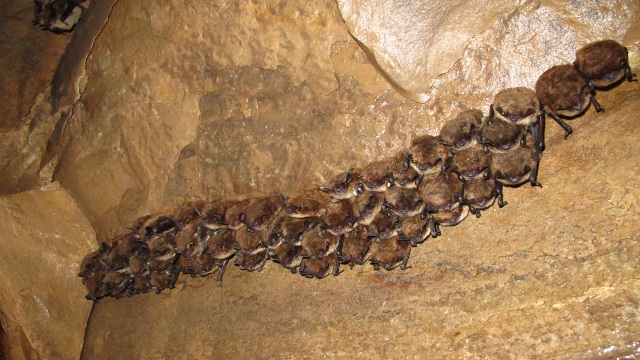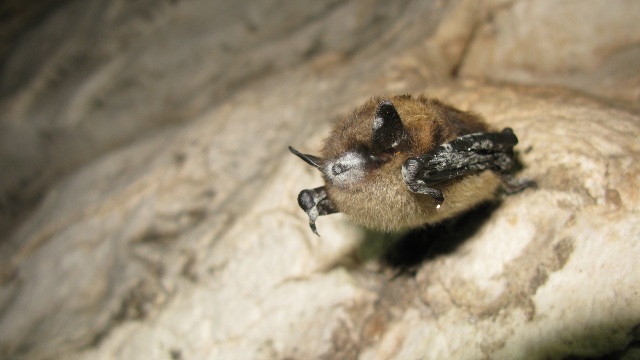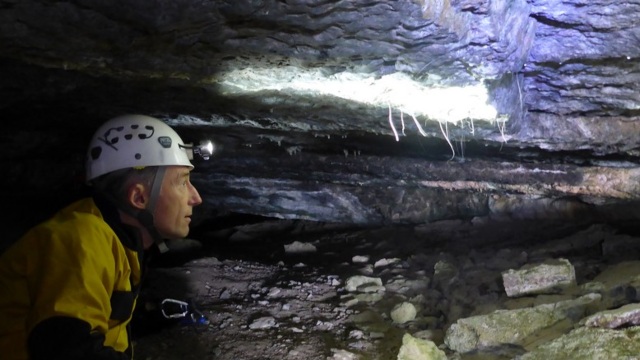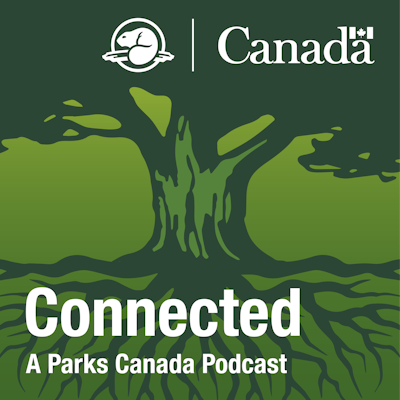
© Brock Fenton
Little brown bat
Kootenay National Park
Quick facts
Eats flying insects like mosquitoes, moths, and beetles
Navigates using echolocation and vision
Weighs on average 7.4 g (a bit heavier than a loonie)
Lives around 30 years
SARA status: Endangered (2014)
The little brown bat is also called little brown myotis. The word “myotis” means “mouse-eared,” and refers to its relatively small, mouse-like ears. Little brown bats are one of the most well-known bat species in Canada. They like to roost in buildings and are often seen flying at night, catching insects over lakes and around streetlights.
Bats can eat half their weight in insects every night. They play an important role in keeping insect populations in check and are beneficial to forestry and agriculture — a form of pest control that doesn’t require chemicals!
Connected: A Parks Canada Podcast New
All animals and plants are protected inside the national parks, but some need extra help. Connected will introduce you to species at risk that are in danger of disappearing.
In Episode 6: Little Brown Bat (10:28), Wildlife Ecologist Anne Forshner introduces us to the world of little brown bats. Discover how Parks Canada is learning more about the lives of these flying mammals, like where they like to roost. Ultimately, this knowledge will help us fight a deadly and looming threat — white nose syndrome.
Where they live
Little brown bats are active at night, and rest during the day in roosts. Roosts can be human-made structures like buildings, cook shelters, mines, and bridges. Or they can be natural structures like caves, tree cavities, and rock-crevices. Different roosts are used for different activities.
Little brown bats hibernate during the winter months in cold, humid spaces called hibernacula. The most common hibernacula are caves. In early summer, female bats give birth in safe spaces called maternity roosts. A recent study in Banff, Yoho, and Kootenay National Parks found that little brown bats only used buildings as maternity roosts.


Why they are at risk

White-nose syndrome
White-nose syndrome is a fungal disease that infects bats during hibernation, causing them to wake often and use up energy stores. Bats may also leave their hibernaculum too early and starve or freeze to death outside. The fungus appears as a white powder on the bat’s nose, ears, and wings.
White-nose syndrome spreads quickly from bat to bat and can kill up to 99% of bats at a site. Between 2006 and 2012, an estimated 5.7-6.7 million bats in eastern North America died from white-nose syndrome. Since then, the disease has spread westward. The fungus was first documented in Alberta and British Columbia in 2021/22. Currently, there are no known cases of bats with white-nose syndrome in the mountain national parks.
Human disturbance
Public opinion of bats can be negatively shaped by media and myth. Bats are often viewed as ugly, scary, disease-carrying pests. As a result, bats are particularly vulnerable to human disturbance.
Outside the national parks, bats have been exterminated, and their roosts removed from buildings. Homeowners and businesses may have health concerns about the diseases bats can carry, and a build up of bat feces.
How Parks Canada is helping
Monitoring
In addition to little brown bats, there are at least eight other bat species in Banff, Yoho, and Kootenay national parks. Parks Canada identifies and monitors bat populations using different methods:
- Stationary and mobile ultrasonic bat detectors
- Lab analysis of guano (bat poop)
Parks Canada also contributes to the North American Bat Monitoring Program.
Protecting roosts
In the national parks, little brown bats and their roosts are protected by law under the National Parks Act and Canada’s Species at Risk Act. It is illegal to harm or disturb bats and their occupied or unoccupied roosts. Violators will be charged, be required to appear in court, and could pay fines up to $25 000.
When bats are found in buildings, Parks Canada works with residents and businesses to help people and bats safely coexist.
Protecting caves
Natural caves are important hibernation sites for bats. It is illegal to enter any cave in the national parks without a permit. When cave access is required for research, Parks Canada staff and researchers follow decontamination protocols so that they don’t spread the fungus that causes white-nose syndrome.
Research
Parks Canada collaborates with other scientists and agencies to learn more about bats. For example, staff participated in a study of little brown bats within Kootenay, Yoho and Banff national parks. Data was collected from acoustic monitors, and by capturing and radio tracking bats. The results showed that:
- Buildings were the only roost type used by bats of all reproductive stages. Few bats were captured far away from towns and buildings.
- Maternity colonies (a group of bats that come together to give birth and raise babies) were only found in buildings.
- Some female bats frequently used natural tree and rock roosts, particularly after colder nights.
Learn more about this research: https://doi.org/10.1002/ecs2.4731.


How you can help
If you find a dead, sick or injured bat in the park, report it to Parks Canada at llyk.wildlife@pc.gc.ca. Do not touch or handle the bat. Do not disturb the roost.
When you travel to or from the national parks, check for bats in your camping equipment. For example, inside a patio umbrella or the folds of a tent trailer. Moving a bat could potentially spread white-nose syndrome.
Learn more
The B.C. Community Bat Program
The Alberta Community Bat Program
Species at Risk Public Registry – COSEWIC Assessment and Status Report – Little Brown Bat
- Date modified :
